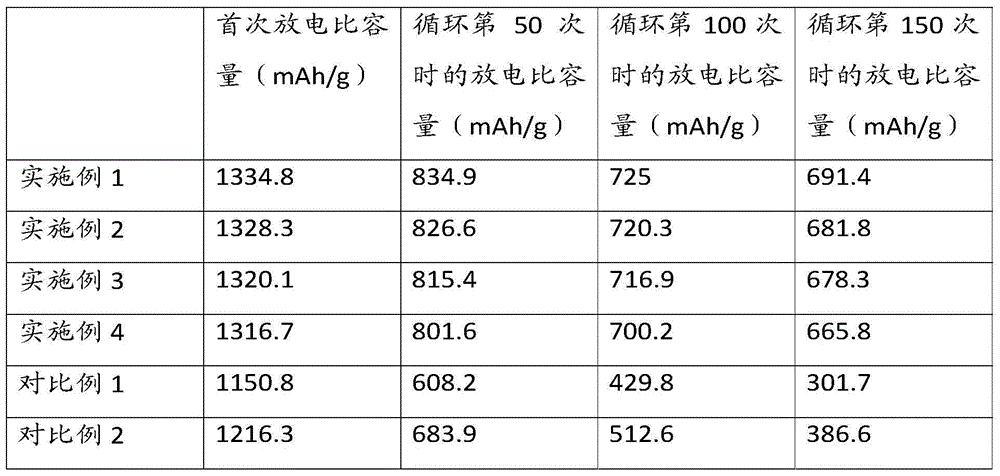Composite material for anodes of lithium sulfur batteries, method for manufacturing composite material and anodes and batteries which are made of composite material
A composite material and lithium-sulfur battery technology, which is applied in battery electrodes, non-aqueous electrolyte battery electrodes, secondary batteries, etc., can solve the problems of electrode volume expansion, low S loading capacity of composite materials, and short cycle life of batteries. Achieve the effect of large surface area and increase S loading capacity
- Summary
- Abstract
- Description
- Claims
- Application Information
AI Technical Summary
Problems solved by technology
Method used
Image
Examples
Embodiment 1
[0040] S11: Preparation of polynaphthalene
[0041] Put 4 g of dried 3,4,9,10-diphenyltetracarboxylic anhydride (PTCDA) in a tube electric furnace, and after three times of vacuuming and filling with argon, adjust the argon flow rate (25mL / min), The tail gas absorption device (absorbing liquid is saturated aqueous solution of calcium hydroxide), and then under the condition that the initial temperature is room temperature, the temperature is raised at a rate of 5°C / min, and the temperature is raised to 530°C, kept at this temperature for 8 hours, and then continued to The temperature was raised at a rate of 5°C / min, the temperature was raised to 1000°C, and maintained at this temperature for 6 hours, and then the temperature was naturally lowered to obtain polynaphthalene.
[0042] S12: Preparation of polynaphthalene / sulfur composites
[0043] 7.22g sodium thiosulfate is completely dissolved in 150mL high-purity water, then 0.5g of the obtained polynaphthalene is added to the...
Embodiment 2
[0049] S21: Preparation of polynaphthalene
[0050] Put 2 g of dried 3,4,9,10-diphenyltetracarboxylic anhydride (PTCDA) in a tube electric furnace, and after three times of vacuuming and filling with argon, adjust the argon flow rate (25mL / min), The tail gas absorption device (absorbing liquid is saturated aqueous solution of calcium hydroxide), and then under the condition that the initial temperature is room temperature, the temperature is raised at a rate of 5°C / min, and the temperature is raised to 530°C, kept at this temperature for 8 hours, and then continued to The temperature was raised at a rate of 5°C / min, the temperature was raised to 1100°C, and maintained at this temperature for 6 hours, and then the temperature was naturally lowered to obtain polynaphthalene.
[0051] S22: Preparation of polynaphthalene / sulfur composites
[0052] Dissolve 12g of sodium thiosulfate completely in 150mL of distilled water, then add 0.5g of the prepared polynaphthalene into the sodi...
Embodiment 3
[0058] S31: Preparation of polynaphthalene
[0059] The preparation method is the same as S11.
[0060] S32: Preparation of polynaphthalene / sulfur composites
[0061] In this step, the quality of sodium thiosulfate used is 18g, dissolved in 180mL of high-purity water, the quality of polynaphthalene used is 0.5g, the concentration of hydrochloric acid added dropwise is 12mol / L, and the volume is 23mL. The specific preparation steps are the same as S12, which will not be described in detail here.
[0062] S33: Preparation of porous titanium dioxide-wrapped polynaphthalene / sulfur composites
[0063] The preparation method is the same as S13.
PUM
 Login to View More
Login to View More Abstract
Description
Claims
Application Information
 Login to View More
Login to View More - R&D
- Intellectual Property
- Life Sciences
- Materials
- Tech Scout
- Unparalleled Data Quality
- Higher Quality Content
- 60% Fewer Hallucinations
Browse by: Latest US Patents, China's latest patents, Technical Efficacy Thesaurus, Application Domain, Technology Topic, Popular Technical Reports.
© 2025 PatSnap. All rights reserved.Legal|Privacy policy|Modern Slavery Act Transparency Statement|Sitemap|About US| Contact US: help@patsnap.com


